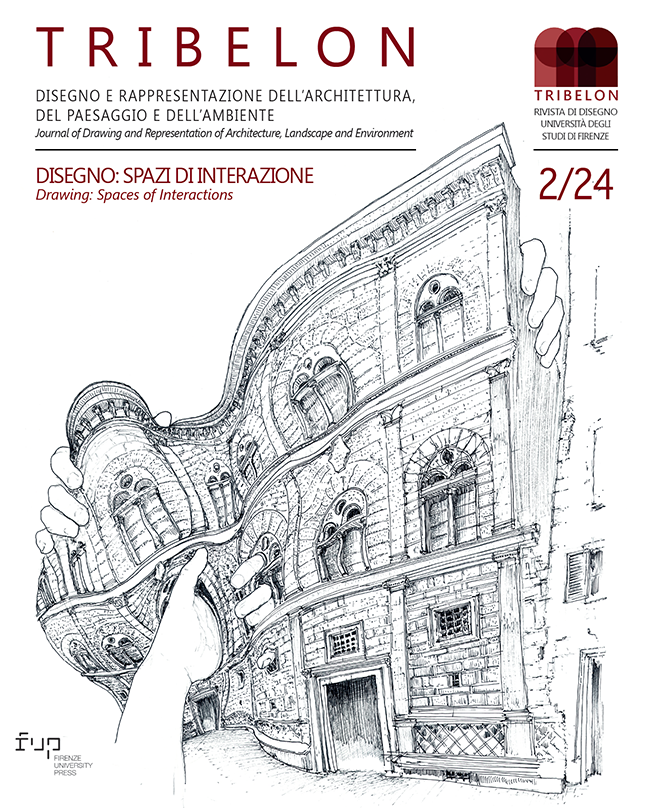Published 2024-12-19
Keywords
- Venice’s lagoon,
- digital twins,
- 3D interoperable models,
- HBIM,
- 3D semantic infrastructure
How to Cite
Copyright (c) 2024 Ludovica Galeazzo

This work is licensed under a Creative Commons Attribution 4.0 International License.
Abstract
With the fall of the Venetian Republic in 1797 and the subsequent transformation of nearly all sixty lagoon islands into military outposts, not only was an invaluable architectural heritage dismantled, but the very concept of a unified, interconnected archipelago was lost. During the early modern period, these water-bound settlements were crucial to Venice’s urban framework, encompassing a network of capillary infrastructures for the city’s supply, defence, healthcare as well as civic rituals. Today, however, these islands lie abandoned to the lagoon’s capricious waters, with their buildings, architectural elements, and spaces vanished along with their stories. Reconstructing this dilapidated cultural heritage therefore demands a dual focus on both the tangible architectural remnants and the intangible urban, economic, and socio-cultural threads that once wove the capital into its aquascape. The Venice’s Nissology project digitally recreates these peculiar environments in a 3D, interactive, and geospatial infrastructure that visualises, through time and space, the once-thriving islands in both their physical forms and social arrangements. This platform allows for the navigation of 3D interoperable models, seamlessly integrated with historical data and sources, which represent the spaces where to resemantise the long-lasting dynamics of Venice’s centre-periphery relations, re-evaluating the archipelago’s role as a fundamental connective tissue in the city’s urban practices.
References
- B. Bordone, Isolario di Benedetto Bordone nel qual si ragiona di tutte l’isole del mondo […], per Nicolò d’Aristotile detto Zoppino, in Vinegia 1528.
- E. Concina (a cura di), “Tra due elementi sospesa”. Venezia, costruzione di un paesaggio urbano, Insula-Marsilio, Venezia 2000.
- V.M. Coronelli, Isolario, descrittione geografico-historica [...], 2 voll., a’ spese dell’autore, in Venetia 1696-1697.
- M. Crovato e G. Crovato, Isole abbandonate della Laguna. Com’erano e come sono, Liviana, Padova 1978.
- C. de Seta, Introduzione, in Id. e D. Stroffolino (a cura di), L’Europa moderna. Cartografia urbana e vedutismo, Electa, Napoli 2001, pp. 11-56.
- I. di Lenardo, Venezia e l’invenzione del paesaggio urbano tra laguna e città, in D. Calabi e L. Galeazzo (a cura di), Acqua e cibo a Venezia. Storie della laguna e della città, catalogo della mostra (Venezia, Palazzo Ducale, 26 settembre 2015 - 14 febbraio 2016), Marsilio, Venezia 2015, pp. 39-42.
- L. Galeazzo, Autorità ecclesiastica e civile nell’iconografia dell’arcipelago veneziano tra XVI e XVII secolo, in In_BO. Ricerche e progetti per il territorio, la città e l’architettura, 12, 2021, 16, pp. 186-197.
- L. Galeazzo, The Venetian Archipelago: Society, Everyday Life, and Cultural Exchange in the Early Modern Lagoon, in E. Svalduz (ed. by), Market Spaces, Production Sites, and Sound Landscape of European Cities: From History to Regeneration, Padova University Press, Padova 2022, pp. 69-78.
- L. Galeazzo, Venice’s Nissology: Mapping and Modelling Venice’s Aquascape in a Historical Perspective, in Storia Urbana, 173/2022, 2024, pp. 31-45.
- L. Galeazzo, R. Grillo e G. Spinaci, A Geospatial and Time-based Reconstruction of the Venetian Lagoon in a 3D Web Semantic Infrastructure, in E. Bernasconi, A. Mannocci, A. Poggi, A. Salatino e G. Silvello (eds.), CEUR Workshop Proceedings, vol. 3643, pp. 212-225.
- L. Galeazzo e S. Parrinello, Historical and 3D Survey Analyses for an Informative Database on the Venetian Fort of Sant’Andrea, in G. Islami and D. Veizaj (eds.), Defensive Architecture of the Mediterrean, proceedings of the International Conference on Modern Age Fortification of the Mediterranean Coast, FORTMED 2024, vol. XVII, Universiteti Politeknik i Tiranës, Tirana 2024, pp. 619-626.
- D. Lovisa, Il Gran teatro di Venezia […], per Domenico Lovisa sotto i portici a Rialto, in Venezia 1717.
- G. Mariacher, La laguna vista dagli artisti veneziani (dal XV al XVIII secolo), in Mostra storica della laguna veneta, Stamperia di Venezia, Venezia 1970, pp. 211-218.
- G. Mazzi, Una città sul mare. Miti e utopie per la Venezia del Rinascimento, in G. Borelli (a cura di), Mercanti e vita economica nella Repubblica veneta (secoli XIII-XVIII), Banca popolare di Verona, Verona 1985, vol. I, pp. 3-43.
- S. Parrinello e G. Dellabartola, Il Paesaggio dell’Arcipelago Veneziano. Rilievo integrato e stratigrafia della memoria mediante sistemi di rappresentazione digitale, in M. Valentino, A. Ganciu e A. Fusinetti (a cura di), VL 2024 International Conference on Visualizing Landscape, PUBLICA, Alghero 2024, pp. 856-867.
- A. Pattanaro, Il paesaggio dipinto fra Quattrocento e Cinquecento: storia dell’arte e memoria del territorio, in G. Guidarelli ed E. Svalduz (a cura di), Il paesaggio costruito, il paesaggio nell’arte, Padova University Press, Padova 2017), pp. 91-103.
- T. Pignatti (a cura di), Ventiquattro isole della laguna disegnate da Francesco Tironi, incise da Antonio Sandi, Cassa di Risparmio di Venezia, Venezia 1974.
- A. Stouraiti, Propaganda figurata: geometrie di dominio e ideologie veneziane nelle carte di Vincenzo Coronelli, in Studi veneziani, 44, 2002, pp. 129-155.
- A. Visentini, Isolario veneto […], appresso Teodoro Viero, Venezia 1777.


